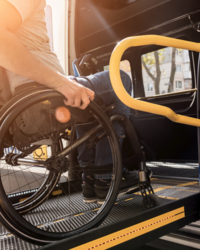Wheelchair Accessible Taxis and Hire Vehicles (WAVs) play an important role in the point to point transport industry by providing safe passenger services for people travelling in wheelchairs.
All drivers providing wheelchair accessible passenger services must be competent in loading, unloading and transporting passengers travelling in a wheelchair.
In addition to the use of safe practices during loading and unloading, it is vital that a WAV driver ensures the wheelchair is safely secured to the vehicle and the passenger travelling in the wheelchair is safely and carefully restrained using the vehicle’s seatbelt.
Background
The Commissioner has recently received reports of some passengers falling from their wheelchairs during WAV journeys due to drivers failing to properly secure the wheelchair with all four tie-down restraints.
All four tie-down restraints must be properly attached, adjusted and checked for proper tension to secure the wheelchair to the vehicle.
Additionally, a passenger who remains seated in their wheelchair during the journey must be restrained with one of the vehicle’s seatbelts. Seatbelts must be the lap and sash emergency locking retractor type or a lap and harness type - the wheelchair’s own lap belt is not a safe substitute for the vehicle’s seatbelt.
The danger
If either the wheelchair, the passenger or both are not securely restrained inside the vehicle, serious injuries, and even fatalities, can occur. These risks are present even if the vehicle is not involved in a collision. Incorrectly restrained wheelchairs can easily topple due to their high centre of gravity and weight, even during normal, smooth driving. Drivers must always check that they have correctly restrained the wheelchair and the passenger travelling in the wheelchair before they begin the journey. Passengers must be securely restrained during every journey, even on the shortest of trips.
Responsibilities
Taxi service providers, facilitators and booking service providers must ensure the driver of a WAV is:
- able to demonstrate competency in the safe loading, restraining and unloading of a person in a wheelchair
- competent in communicating with, and assisting, passengers with differing levels of ability
- able to ensure that the wheelchair is safely secured to the vehicle throughout the hiring.
These competencies must meet elements 3 and 4 of the Commonwealth issued document, TLIC2040 - Provide wheelchair accessible taxi services to passengers with disabilities. Drivers must demonstrate competency with the different types of wheelchair accessible vehicle and wheelchair, and in a variety of relevant locations.
Whether you are a taxi service provider, facilitator of a service or booking service provider providing wheelchair accessible vehicles, you are required to ensure your drivers are competent, and maintain their ongoing competency.
Please read our WAV Safety: Service provider obligations fact sheet for more information.
Drivers
During pre-shift checks, WAV drivers should ensure that the vehicle has enough tie-down restraints to properly secure all the wheelchairs it can legally carry, and that the tie-down restraints are in good condition.
The seatbelts for use by those travelling in a wheelchair must also be in good working order. Damaged or frayed seatbelts lose their ability to protect passengers from serious injuries in the event of an accident.
Tie-down restraint straps and seatbelts should not be damaged, worn, faded or knotted.
It is a driver’s responsibility to securely restrain a passenger seated in a wheelchair. A family member, medical professional or carer must not be allowed to secure the passenger.
Service providers should remind drivers that:
- the driver is responsible for securing wheelchairs in a WAV and for securing the passenger with the vehicle’s seat belt
- the only person who should be attaching and adjusting the four tie-down restraints is the driver
- the driver cannot ask someone to secure, or check that the passenger is secure, on their behalf.
A full list of responsibilities for drivers is detailed in our WAV Safety: Safety obligations for drivers fact sheet.
Penalties
Penalties The law requires the driver of a WAV that is transporting a person using a wheelchair to ensure that the wheelchair is safely secured to the vehicle throughout the hiring.
Drivers can face fines of up to $1,100 where they do not comply with this requirement. In the most serious cases, drivers may be prosecuted and, if found guilty, removed from the industry.
Resources
More information on safety standards for wheelchair accessible vehicles can be found on the Point to Point Transport Commissioner’s website:
